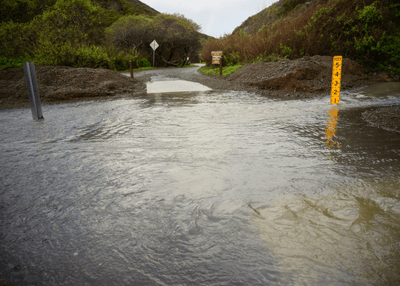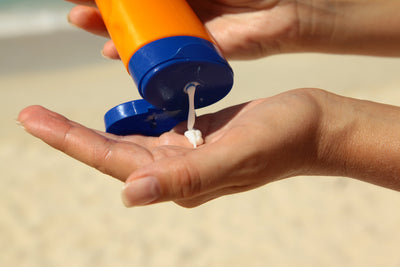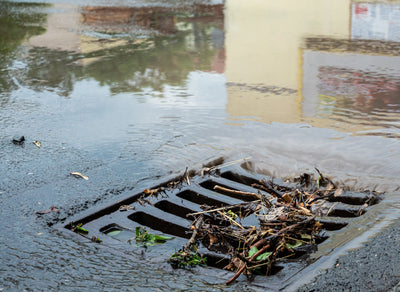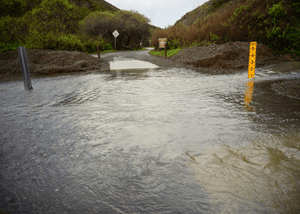Recent storms and atmospheric rivers can cause problems with drinking water infrastructure and both public & private water systems. Here's how you can protect yourself.
Water Quality InformationWritten By Actual Experts
RSSSevere Weather Can Impact Drinking Water Quality

How Does Deforestation Impact Water Quality?

Analies Dyjak, M.A. & Christina Liu, B.S., M.B.A.
Globally, we have lost one-third of the world’s forests, or 2 billion hectares (an area twice the size of the United States). More often than not, humans are responsible for deforestation. The land that surrounds a body of water plays a critical role in water quality and availability. Forested land not only acts as a “natural filter” for incoming water, but also reduces the risk of flooding.
What Is Deforestation?
Forested areas are cleared to make way for agriculture, commercial buildings, homes, and other large scale construction projects. Deforestation results in significant changes to the surrounding and global ecosystems, and habitat loss can lead to species extinction. The most extreme examples of this include the Amazon Rainforest, which has shrunk 18% in the last 40 years. Illegal mining, illegal logging, agricultural expansion, lack of government control, and climate change have all contributed to deforestation in the Amazon.
Deforestation has lesser-known secondary consequences that are becoming a focal point for scientists. Trees absorb carbon dioxide and release oxygen back into the environment. Without trees, the carbon accumulates in the atmosphere which contributes to rising global temperatures.
How Does Deforestation Impact Drinking Water Supplies?
Reduction in Rainfall and Global Implications:
Forests help control the water cycle by regulating rainfall and evaporation. The layers of the forest canopy, branches, and roots store and release water vapor, which helps to control rainfall. Forests also help reduce the impacts from flooding by blocking and slowing down the flow of runoff from storms. Deforestation, however, weakens this process, leading to irregular rainfall, including drought and flooding.
Also, while deforestation may occur locally, its effects are global. For example, in a 2005 study, deforestation of Central Africa caused a decrease in precipitation of about 5%–15% in the Great Lakes region, mostly centered in Illinois, with a peak decrease of about 35% in February. In addition, a 25% decrease in rainfall in Texas was attributed to Amazon deforestation. While the three major forest basins do not respond the same, deforestation in other areas have also been observed to cause changes in rainfall and the water cycle elsewhere in the world. The decrease in rainfall combined with the increase in water usage across the United States are contributing to severe drought and aridification throughout many states.
Increased Erosion and Runoff:
Forested land does a lot of the “heavy lifting” in terms of filtration. Soil absorbs pollutants and helps to slow the rate of flowing water. The tree roots also anchor soil against erosion, which reduces runoff, and lowers downstream water treatment costs. When forests are disturbed and degraded, (from deforestation or wildfires or a combination of the two), sediment flows into streams and pollutes water.
Reduced Water Quality/Access to Drinkable Water:
Scientists conducted a study in Malawi on deforestation and water quality. They found that when deforestation increased 1%, it was equivalent to a nearly 1% decrease in access to clean water, which was equivalent to a decrease in rainfall of nearly 10%. They also observed that access to source water did not mean people had more drinkable water. Deforestation increases soil erosion, resulting in higher soil, sediment, and turbidity levels in the water, increasing the need for drinking water treatment.
Other Articles We Think You Might Enjoy:
Wildfires and Water Quality
How Do Hurricanes Affect Your Drinking Water?
Why Home Water Filters Are Better For The Environment
Things You Should Avoid Pouring Down The Drain

Analies Dyjak, M.A. & Christina Liu, B.S. | Science Team
Whenever we pour something down the drain or flush the toilet, it’s easy to think “out of sight out of mind.” However, the things we put down the drain can impact water quality in a big way. This article highlights exactly what not to pour or flush down the drain.
Where Does The “Stuff” That Goes Down The Drain Go?
All of the water flushed or washed down the drain goes through your city’s sewer system and into the wastewater treatment facility. The water that’s used to flush your toilet, take a shower, or wash your dishes all end up in the exact same spot. The wastewater treatment facility will treat the used water for a variety of pollutants. Once the water goes through the various processes, it’s released into local waterways to be recycled for a number of different purposes (including drinking water!).
Do Wastewater Treatment Plants Remove “Everything”?
It’s easy to assume that a wastewater treatment plant might remove absolutely everything from incoming wastewater. That isn’t entirely the case. Wastewater treatment plants do a really good job at removing larger solids, biological/bacterial contaminants, and sediment. They do not remove many chemicals, pharmaceuticals, hazardous materials, industrial waste, or pesticides. This puts a lot of pressure on drinking water treatment plants to carry a majority of the tap water purification. Some wastewater treatment plants are outdated and aren’t able to remove these types of pollutants, while others are not even required to do so. Click here for an in-depth video on how wastewater treatment plants actually work.
To help ease the burden on wastewater and drinking water treatment plants, here’s a list of things you should never pour or flush down the drain:
Pharmaceuticals: Old or unwanted prescription/over-the-counter medications should never be flushed down the toilet or sink. Water treatment plants are unable to remove most pharmaceuticals, which means that trace amounts end up in our tap water. Small amounts or levels below therapeutic doses are currently not a cause for concern but if people continue to dispose of medications down the drain, these levels of pharmaceuticals may accumulate. For guidance on how to properly dispose of pharmaceuticals, check out the FDA’s best practices for disposal of unused medicines.
Grease: Aside from the obvious reasons why you should never pour grease, oils, or fats down the drain, doing so can actually cause issues at a much larger scale. Whatever grease you pour down the drain congeals with everyone else's, and can form a mass in the sewer system. The mass can block other wastes from passing through, creating a major sewage blockage (like we saw in Detroit, MI). Check your city’s municipal utility company to see if they have a cooking oil collection program. If not, the best recommendation is to collect the used oil in a leakproof jar, seal it up, and throw it away in the trash.
Motor Oil: Never pour used motor oil or other automotive fluids (including antifreeze, solvents and gasoline) down a drain in your house or garage, into a storm drain, onto the soil, into a waterway, or in a manhole on a sidewalk. Used motor oil can contain toxic heavy metals such as zinc, lead, and cadmium that can contaminate drinking water. In fact, one quart of oil poured down a storm drain can contaminate one million gallons of water. One pint of oil can produce a slick of approximately one acre of water. When oil enters a body of water, a film develops on the surface that blocks out sunlight that plants and other organisms need to live. Please note that unlike cooking oil, you also cannot dispose of motor oil in the trash, and many cities will issue stiff fines for dumping toxic waste into landfills. Always bring used motor oil to local used oil collection centers.
Paint: Whether it’s latex, acrylic, or oil, paints can clog your pipes and potentially leach toxic compounds into the water. If you can, first try to see if the leftover paint can be reused. School drama clubs or community theaters will often be happy to take unused paint! If the paint can’t be reused and must be disposed of, avoid throwing it away. Bring paint to local household hazardous waste collection locations/events. Don’t clean brushes in the sink, but use rinse buckets, and let the paint residue settle overnight from the old rinse water before pouring the water down the sink, leaving the congealed and dried paint at the bottom of the bucket, where it can be peeled or scraped off and thrown away.
Important Takeaways:
Wastewater treatment plants are primarily designed to treat the biological materials in the water, but are NOT equipped to treat the water for chemicals such as pharmaceuticals, cooking oil, household grease, motor oil and other automotive fluids, paint, photographic chemicals and others. A good rule of thumb is, when in doubt, don’t pour it down the sink or into sewer or storm drains. Check with your local authorities for toxic waste disposal locations.
Other Articles We Think You Might Enjoy:Don't Drink or Cook With Water From The Hot Side of Your Faucet
6 Myths About Drinking Water
Why Home Water Filters Are Better For The Environment:
Oxybenzone and Drinking Water

Emily Driehaus | Science Communication Intern
Oxybenzone is a common sunscreen ingredient that has been shown to have negative impacts on human health and the environment. Evidence has shown that it can contaminate drinking water after being washed down the drain while showering off sunscreen.
What is Oxybenzone?
Oxybenzone is a UV filter used in sunscreen and other cosmetics. It absorbs UV rays from the sun and helps prevent them from penetrating the skin and causing sun damage. While it does help protect our skin against the sun, it has implications for both our health and the environment, particularly aquatic life.
Oxybenzone and Marine Life
Much of the concern regarding oxybenzone began when researchers noticed damage to coral reefs near beaches with many visitors. As sunscreen gets sloughed off the skin by the water and sand, it can make its way into the ocean and harm aquatic life. Coral reefs are especially susceptible to damage, as oxybenzone can harm normal growth and development, damage DNA and put them at an increased risk of bleaching.
Health Implications of Oxybenzone
As research into oxybenzone has continued, it has been designated as an endocrine disruptor. Endocrine disruptors interfere with normal hormonal processes in the body and can impact the reproductive system. Most research on oxybenzone in the human body has focused on absorption through the skin rather than ingestion, but more evidence has shown that oxybenzone is present in drinking water, especially in communities near large bodies of water.
How Does Oxybenzone Get Into Drinking Water?
After a day at the beach, most individuals hop in the shower to rinse off the sunscreen and sand that has accumulated on their skin throughout the day. When this water goes down the drain, it goes to wastewater treatment plants to be treated before being released into water sources, which can be used for drinking water. Wastewater treatment plants and drinking water facilities lack the ability to filter out endocrine disruptors like oxybenzone, so it ends up in drinking water consumed by the public. A study looking at oxybenzone in Honolulu tap water showed that individuals consume between 0.8-1.2 micrograms of oxybenzone a day from drinking water. This concentration is not particularly harmful to fully grown adults, but can have a greater impact on children, infants and developing fetuses.
Regulations on Oxybenzone
The previously mentioned study was submitted as part of testimony on a bill that would ban the sale of sunscreens containing oxybenzone in the state of Hawaii. The bill passed in 2018 and went into effect at the beginning of this year. The city of Key West, Florida has also enacted a ban on sunscreens with oxybenzone in an effort to protect coral reefs. These bans are not without controversy, as skin damage from UV rays can lead to skin cancer and banning sunscreens with oxybenzone leaves individuals in these areas with one less form of sun protection.
What Should I Do if I’m Concerned About Oxybenzone in my Water?
Carbon water filters are able to filter out oxybenzone and other endocrine disruptors. Using sunscreen with ingredients like zinc oxide or titanium dioxide rather than oxybenzone can also reduce your overall exposure. Switching sunscreens will also help protect aquatic life when you swim in bodies of water like lakes or oceans.
Other Articles We Think You Might Enjoy:BPA and Phthalates: Are These Two Endocrine Disruptors in Your Water?
Trump's "Dirty Water Rule" to be Revised
Drinking Water Supplies Risk Contamination from Toxic Wastewater Ponds
How Does Stormwater Runoff Affect Drinking Water?

*Updated 3/2/22 to include recent study*
Analies Dyjak | Policy Nerd
Heavy rains and snowmelt can carry a lot of unwanted contaminants into drinking water sources. Here’s how stormwater runoff can affect your water.
How Does Stormwater Affect Drinking Water?
Heavy rain storms create a rapid influx of water, which can cause a host of health and environmental issues. Rainwater travels to low-lying bodies of water, including oceans, lakes, rivers, streams, and aquifers. Both surface and groundwater are susceptible to contamination from stormwater runoff, both of which are sources of drinking water. As water travels, it picks up loose debris, pesticides, herbicides, oil, and other types of pollution in its path. This cocktail of contaminants is then dumped into a nearby waterway. Some municipal water treatment facilities are equipped to deal with these types of contamination, while others are not. 86% of the U.S. population gets their drinking water from surface water sources, so maintaining clean lakes and rivers is extremely important for managing stormwater runoff pollution in drinking water.
Road Salt and Drinking Water Contamination
70% of the US population lives in areas that experience ice and snow, and rely heavily on road salts and other deicing techniques to maintain road safety. Road salts are crucial for decreasing automobile accidents, but they can have some unintended consequences on the environment. A recent study found that freshwater contamination from these deicing materials causing significant increases in the salinity of the freshwater, resulting in issues with native wildlife and widespread contamination of drinking water supplies. The contamination is primarily from excess chloride and sodium, which affects both surface water and groundwater, for municipal water suppliers as well as private wells. In addition, deicing salts can leach heavy metals (such as mercury, lead, cadmium, copper, and zinc) from sediment and plumbing pipes into the drinking water. In groundwater, sodium can also mobilize dissolved radium, increasing the risk of radon exposure to homeowners.
What Are Combined Sewer Overflows or CSO’s?
Combined Sewer Overflows or CSO’s, are a system of underground canals that collect stormwater runoff, industrial wastewater, and sewage all in the same pipe. Under normal conditions, stormwater and sewage travels to a wastewater plant where it’s treated before being discharged into a body of water. During heavy rain events, the large influx of stormwater causes pipes to exceed the capacity of the the system. Untreated wastewater, including sewage, overflows into nearby oceans, lakes, rivers or streams or wherever a stormwater discharge output exists. CSO’s were used as early as the 1850’s, and were the only system in place to deal with such high volumes of water. Many cities have replaced CSO’s with advanced infrastructure, but cities such as Portland, Maine and Cambridge, Massachusetts still use them.
Impervious Surfaces and Stormwater
Impervious surfaces are developed areas where water is unable to infiltrate into the earth. This typically refers to paved roads, roofs, and sidewalks. When water is unable to infiltrate, it flows into the nearest body of water or wastewater system. Impervious surfaces are of concern because water picks up and carries dangerous contaminants, then deposits pollution into drinking water sources. Impervious surfaces also increase the impacts from floods. Unable to percolate, water sits on top of paved roads, increasing the flood potential and presence of biological contamination. As communities continue to develop, the area of paved or impervious surface increases as well.
Wetlands: Important for Stormwater Retention
Wetlands offer remarkable protection from the impacts of flooding and other stormwater damages. Wetlands absorb incoming water and release it slowly, acting as a natural sponge. According to the U.S Army Corps of Engineers, the state wetland conservation along the Charles River in Boston, Massachusetts saved approximately $17 million in potential flood damage. Additionally, wetlands naturally filter stormwater runoff pollution. The fast-moving water is slowed by vegetation, which allows suspended sediment and pollution to fall to the bottom.
Other Articles We Think You Might Enjoy:Surface Water: What You Need To Know
Agricultural Runoff: Why It's A Problem And What's Being Done To Stop It
Nitrates In Drinking Water






